
A
WORD FROM RBO's EDITOR:
We are pleased to have
many visitors from around
the world on this page.
Please, feel free to
download the audio-file
and to use it cost-free.
However, this will be
under the condition that
you inform RBO about
intended use by sending a
mail to: radiobridge@aol.com
Any other feedback would
also be appreciated.
The copyright remains
with RBO. |
"MAKING
IT WORK"
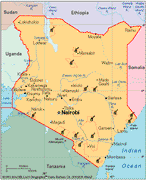
IN KENYA - EPISODE A
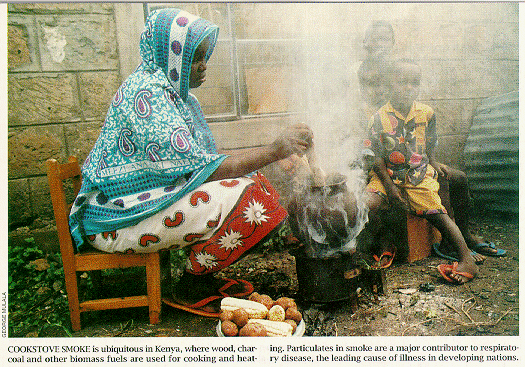
Half the World's
population of nearly six
billion people prepare
their food and heat their
homes with coal and the
traditional biomass fuels
of dung, crop residues,
wood and charcoal. The
procurement and
consumption of these
fuels define the
character of everyday
life in many developing
countries.
In
rural areas, women and
children may spend
several hours a day
collecting wood for
cooking or making
charcoal, tasks that
contribute to
deforestation and soil
erosion. Worse, the
choking smoke from indoor
wood fires causes
respiratory disease -
mainly pneumonia - which
is the leading health
hazard in developing
nations and annually
kills four to five
million children
worldwide.
Living in
the city provides no
refuge. The urban poor
frequently spend a
significant fraction of
their income on the
purchase of charcoal and
wood. Combustion of
biofuels contributes to
the hazy pall that hangs
over the cities of the
developing world. Carbon
dioxide, methane and
other greenhouse gases
from cooking fires may
also foster global
warming.
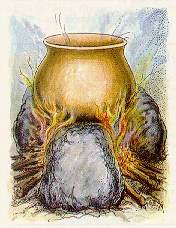 |
OPEN FIRE
used for cooking in the
millions of rural homes
transfers heat to a pot
poorly. As little as 10
percent of the heat goes
to the cooking utensil;
the rest is released to
the environment.
|
The first improved stoves
began to appear in the
early 1980s and were
designed by aid groups
such as UNICEF and
CARE-Kenya. The response
from stove users was
mixed at best. The
designers, mainly natives
of the U.S. and Europe,
two havens of
consumerism, had
forgotten the first thing
about marketing. Field
testing was all too
brief, sometimes with
pathetic results. In one
of the first models, the
stove's opening did not
match the size of most
pots.
| The KENYA
CERAMIC JIKO increases
stove efficiency by
addition of a ceramic
insulating liner (the
brown element), which
enables 25 to 40 percent
of the heat to be
delivered to the pot.
From 20 to 40 percent of
the heat is absorbed by
the stove walls or else
escapes to the
environment. In addition,
10 to 30 percent gets
lost as flue gases, such
as carbon dioxide. |
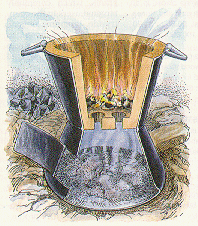 |
The design for one early
improved Jiko model
emerged after an aid
group named the Kenya
Renewable Energy
Development Program
sponsored a research trip
to Thailand to inspect an
improved stove - the Thai
bucket. The resulting
Jiko design had
inward-sloping metal
walls, like the Thai
stove, as well as an
insulating liner made of
ceramic and a mica called
vermiculite. The liner
was cemented from the top
to the bottom of the
inner surface walls. It
caused excessive amounts
of heat to be retained
inside the tapered
vessel. Metal fatigue
resulted from exposure to
the trapped hot gases,
which caused structural
segments to crack.

Better stove designs
gradually came about
during the mid-1980s. At
that time, a number of
academics began to
publish serious analyses
of optimal stove
combustion temperatures
and of the insulating
properties of the ceramic
liner materials. One of
the most notable
contributions to enhanced
design came through the
responses of several
women's organizations
that had formed around
such issues as community
health and protection of
the environment. These
groups were part of a
feminist movement
spreading throughout the
developing world. In
Kenya, it was women who
suggested recasting the
metal bucket design, with
its unstable narrow base,
into an hourglass shape.

That alteration prevented
the new stove from
tipping over, a constant
danger when food was
vigorously stirred in the
Thai-influenced,
bucketlike implement. It
also meant that the
insulating liner need
extend only from the
upper lip to its
narrowest circumference
at the stove's middle -
and the tapered shape let
the liner rest stably
cemented to the upper
metal walls without
falling into the stove's
bottom cavity. Because
the liner covered only
half the stove's
interior, it did not
cause the overheating and
consequent cracking that
had plagued the early
versions.

These design changes,
along with extensive
training programs
established by aid groups
and women's
organizations, caused
dramatic gains in
acceptance for the more
efficient stoves.
Schools, churches and
businesses were among the
first owners and helped
to spark the interest of
individual buyers. Today
hundreds of Jua Kali
manufacturers provide
stoves to some 20,000
purchasers every month.

BENEFITS OF
THE JIKO
The
ceramic Jiko has had a
considerable impact on
household finances.
Typical savings of 1,300
pounds of fuel a year
frees up about $65 per
household - up to a fifth
of the annual income for
urban dwellers. Women
have benefited in that
they control a
disproportionately small
share of family income
yet are the primary
purchasers of fuel. The
Kenya ceramic Jiko has
improved their lot in
important ways. Many have
invested the savings from
reduced fuel purchases in
small businesses or
school fees for their
children.
GEORGE
MSUMBA OF RBO
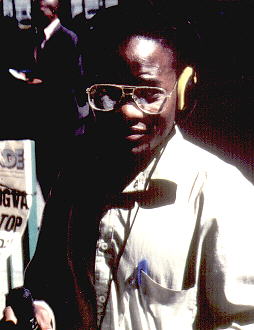
REPORTING FROM KENYA
"How
to cook food faster and
cleaner
without using a lot of
wood"
14'58" / LISTEN

You can go
back to the introduction
page by hitting the
button above.

You can go to the next
episode by hitting this
button,
or you access episodes of
your choice by clicking
on one of the thumbnails
below.


|